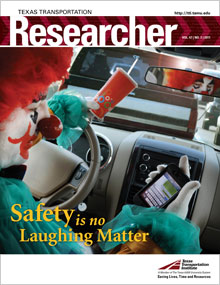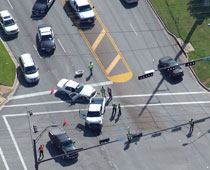Safety Conference Fuels Lifesaving Passion

For those attending the 2011 Traffic Safety Conference in Austin this spring — hosted by the Texas Transportation Institute’s (TTI’s) Center for Transportation Safety (CTS) — the substantial decline in Texas traffic deaths over the last two years, while encouraging, just isn’t enough.
The facts: in 2009, there were 11 percent fewer fatalities in Texas compared to the year before, representing a 19 percent decline since 2003. (Preliminary figures for 2010 point to a further decline.) That’s impressive considering the dramatic increase in both the Texas population and vehicle miles traveled.
“The Texas fatality rate is now at the lowest level since the state began calculating fatality rates in 1935,” Director Terry Pence of the Texas Department of Transportation’s Traffic Safety Section told attendees. “Almost 94 percent of Texans are buckling up every time they drive.” He also credited safer roads and vehicles, public safety campaigns, and people driving less because of the economy and higher gas prices.
Janice Brown, the Federal Highway Administration’s Texas administrator, credited the state’s $1.2 billion bond program for improving safety. “These investments are paying off,” she said.
Both Brown and Pence pointed out that more than 3,000 people, the second highest number of fatalities in the nation, still die each year on Texas roadways. Alcohol is a factor in almost 40 percent of these deaths.
“Every single one of our crashes where someone dies is avoidable and preventable,” said Austin Police Chief Art Acevedo. “Rarely is it a mechanical failure. The majority of the time it’s about behavior.”
In fact, changing driving behaviors in order to improve safety seemed to be the underlying theme of the two-day conference. The breakout sessions covered topics involving pedestrians, teen and elderly drivers, work zone and motorcycle safety, freight operations, and child passenger occupant protection. Other issues included enhancing prosecution of DWI, speed management, safety belts and distracted driving.
TTI Assistant Research Scientist Joel Cooper pointed to the enormous toll that inattention has on safety. “Twenty percent of [nationwide] injury crashes in 2009 involved driver distraction, representing 5,474 deaths that same year. I believe this number is an understatement, but still the number is pretty staggering,” Cooper said.
Attendees agreed that changing the culture is necessary in order to change behavior but also acknowledged it will be a time-consuming, difficult process.
“Before, it was cool to have your cell phone in the car,” TxDOT Media Relations Officer Kelli Petras said during the closing session. “It was cool to always be connected, and now we are trying to change that attitude back into ‘it’s dangerous…you can cause an crash.’”
Petras was part of a round-table discussion designed to get other perspectives about traffic safety. She was joined by former Texas State Representative and Senator David Cain, National President of Mothers Against Drunk Driving Laura Dean-Mooney, CEO of EnviroMedia Social Marketing Valerie Davis and Associated Press Reporter Jim Vertuno.
At the conclusion of the conference, CTS Director John Mounce thanked the closing session round-table members. He borrowed a line from the luncheon speaker, Bella Dinh-Zarr, as he urged unity in the effort to change driver behavior in Texas.
“If you want to act quickly, act alone. If you want to go far, act together,” Mounce told the crowd. “We’ve got a great distance to go, but together we are going to get there. We are going to save some lives, and that’s what we are here for.”

